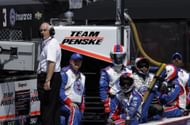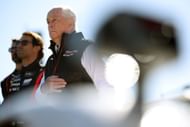Roger Penske's ambition is evident in his legendary record in both racing and business, but he also knew when to pull the brakes. In May 2022, ahead of the 106th Indy 500, the Team Penske owner dismissed the idea of a brand new car for the series, citing the immense financial toll it would take across the paddock.
Penske revealed the economic reality facing American open-wheel racing while speaking to NBC Sports. As the steward of IndyCar's top institutions, Penske had invested over $30 million into IMS upgrades by 2022. But as he planned the first full-capacity Indy 500 since the pandemic began, a clear theme emerged.
"I'm not in a hurry. We pushed the rules in Indy Lights out a few more years. We need to have cars and lower costs. If you took the 33 cars times two, that's 67 cars and each car is $400,000 to $500,000, you are talking $25 to $30 million to come up with before you have any spares. I don't see that happening in today's economy," Penske said to NBC in 2022.
At the time, IndyCar's base chassis, the DW12, was a decade old. The IR-18 aero configuration, introduced in 2018, was the most recent visual and aerodynamic refresh. Yet, Roger Penske's focus remained on technical consistency and lowering costs rather than chasing shiny upgrades.
One of the more controversial calls under his leadership was axing the Freedom 100, an Indy Lights staple on Carb Day. Its history of breathtaking finishes made it a fan favorite, but Penske didn't flinch.

Even the hybrid push was being tempered. The 2.4-liter V6 with hybrid assist, initially slated for 2023, had already been delayed to 2024 due to global supply chain issues. Penske stressed that IndyCar's evolution needs to align with auto industry realities, and Hybrid won't be the end goal.
"Hybrid technology is the bridging technology to the future. I don't think you will see every manufacturer only produce completely electric vehicles for a long time. The products are good. They will always be more expensive," Penske added.
As the Team Penske owner looked ahead, IndyCar's hunt for a third OEM to join Chevrolet and Honda remains unsolved.
How Roger Penske's long-term vision shaped IndyCar's hybrid and chassis future

Three years on, Roger Penske's measured approach to change has largely held. IndyCar returned to 2.2-liter twin-turbo V6 engines in 2023 from the 2.4-liter hybrid engine project. The hybrid component focuses on low-voltage energy recovery and is scheduled to debut at the Mid-Ohio round next month after years of delay and extensive testing.
The Dallara DW12 chassis and IR-18 aero kit remain in the series, and a completely new platform is not expected until 2026. Development is underway for a next-gen car, but the design must balance cost, hybrid integration, and safer oval configurations, something Penske insisted on from the beginning.
Team expansion, meanwhile, has stayed conservative as well. The 2024 Indy 500 featured a 33-car grid, with a few teams planned to run additional entries this season. This year, 34 entries were submitted, and thus, one car was required to be bumped. Jacob Abel was bumped, marking the first time since 2021 that bumping has been necessary due to more than 33 entries
Get the latest NASCAR All-Star race news, Xfinity Series updates, breaking news, rumors, and today’s top stories with the latest news on NASCAR.
